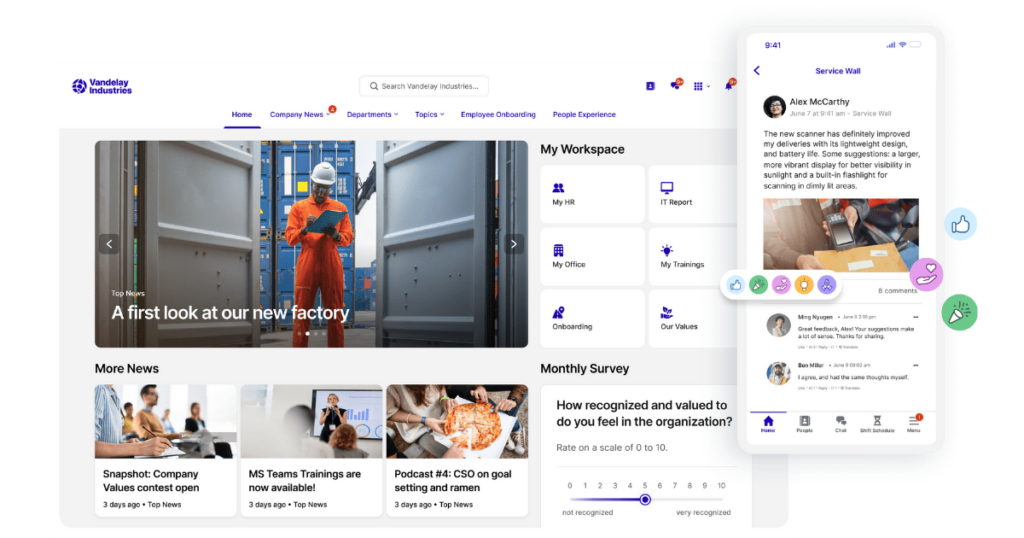40% of employees feel there is a lack of collaboration and communication within their organizations.
Corporate communication is no longer a nice-to-have. Any organization that wants to communicate better and consistently should be concerned.
We’re going through a comprehensive overview to explore the key strategies, functions, and importance of effective corporate communication. Note we’ll address both internal and external dimensions, as you need a mix of the two to build a cohesive workplace culture and strong relationships with target employee audiences.
What is corporate communication?
Corporate communication is the process through which your company can convey messages internally and externally to maintain a consistent image and build relationships.
Strategic and corporate communication commonly involves sharing information with employees, customers, investors, and the public, ensuring that messaging aligns with business goals and fosters a strong corporate reputation and trust.
The role of corporate communication in building a strong workplace culture
An effective corporate communication strategy is first and foremost a must for helping employees understand the company’s values, mission, and goals. By ensuring everyone is on the same page, corporate communication aligns individual efforts with business objectives, boosting motivation and creating a sense of purpose across teams.
This ultimately ties into how your culture evolves. A strong workplace culture is built when employees feel heard and valued. Transparent, engaging communication fosters trust, encourages collaboration, and empowers employees to contribute more effectively, resulting in higher morale and stronger team dynamics.
Kenneth Bonheure, Senior Partner at McKinsey & Company, observes communication is a core enabler of a solid company culture:
“Through consistent, programmatic communication, leaders can help navigate common pain points such as change fatigue, cultural integration challenges, and competing stakeholder relationships. . . . Leaders should continuously engage employees, highlighting the positive aspects of the integration while addressing their questions and concerns. This approach enables leaders to not only get a pulse of the organization but also adapt their communications accordingly and co-create the journey with their teams.”

Internal vs. external corporate communication: Key differences
You can’t however win by focusing on internal corporate communication alone.
Internal communication refers to how a company shares information with its employees. Its primary goal is to engage employees, improve productivity, and align them with the company’s goals.
Internal corporate communications let you focus on:
- Employee engagement: By supporting clear communication, you’ll also pave the way for a work environment that creates a sense of belonging and involvement. Employees who are informed feel more connected to the company’s vision and mission. A Gallup survey showed that nearly three-quarters of employees feel left out of company news, highlighting how important internal communication strategies are.
- Productivity and alignment: When employees receive the correct information on time, they’re better equipped to perform their roles as expected (even exceeding expectations). Tools like intranets, employee apps, and newsletters are what keep teams informed and aligned with business priorities.
External communication, on the other hand, focuses on how the company interacts with the outside world (i.e. customers, media, investors, and partners). You want to include this in your plans to shape your company’s public image and manage relationships with key external stakeholders.
External corporate communications shifts the focus to:
- The company’s brand image: External communication builds and maintains the company’s reputation. Opt for press releases, marketing campaigns, or social media as long as consistent messaging is kept.
- Customer relationships: Companies engage customers through external channels to manage relationships, address concerns, and share product updates, enhancing customer satisfaction and loyalty.
- Stakeholder engagement: Communicating with partners, investors, and media ensures transparent relationships and strengthens the company’s credibility.
Chris Close, Senior Director and Head of Corporate Communications at CF Industries, emphasizes the value of focusing on external benchmarks in shaping internal communications:
“No internal communications program can be successful just by looking inward — we have to bring in new ideas and concepts. But no internal communications program should be judged just by looking externally — we all have unique audiences.”
Core functions of a corporate communications department
A corporate communication plan plays its part through various core use cases:
- Public relations
PR is in charge of managing the company’s external image and relationships with the public, media, and other external stakeholders. The department crafts press releases, organizes media events, and fosters positive media coverage. The strategic value of PR lies in building trust, promoting a favorable image, and enhancing brand credibility.
Real-life scenario:
A great real-world example of effective PR is Dove’s Project #ShowUs campaign. This aimed to challenge beauty stereotypes by creating a collection of over 10,000 images of real women.
Partnering with Getty Images and Girlgaze, Dove encouraged women worldwide to share authentic photos, which companies could use in their advertising. This campaign struck an emotional chord with women, enhancing Dove’s brand image while also generating widespread media coverage and brand loyalty.
- Managing crisis
Crisis management involves anticipating, mitigating, and addressing crises that can harm your company’s reputation. With a crisis communication plan in place, you can respond faster and transparently to any emergency. The outcome? You’ll be prepared to protect the company’s reputation during challenging times, gaining stakeholder trust and reducing risks.
Real-life scenario:
In 2010, Toyota faced a crisis over reports of unintended vehicle acceleration, leading to accidents and a recall of over nine million vehicles. Initially criticized for its slow response, Toyota eventually revamped its crisis strategy by emphasizing transparency, public apologies, and customer safety.
CEO Akio Toyoda publicly apologized and testified before Congress. Toyota then launched its recall efforts, maintained direct communication with customers, and worked on improving media relations. It also conducted third-party safety investigations and put up a “Safety First” ad campaign. This comprehensive response helped restore public trust and regain Toyota’s reputation for reliability and safety.
- Internal comms
Before all else, you should make sure your employees stay well-informed and aligned with your goals. Do this through internal newsletters, intranet platforms, and employee engagement campaigns. Focus on this if you want to keep your team engaged and build a solid workplace culture where everyone can thrive and perform well.
Real-life scenario:
In April 2018, Starbucks announced it would close all 8,000 U.S. company-owned stores for racial bias education, affecting nearly 175,000 employees. This initiative followed an incident of racial bias in a Philadelphia store. CEO Kevin Johnson emphasized the company’s commitment to addressing discrimination and fostering an inclusive environment.
The training program covered implicit bias and conscious inclusion, later becoming part of the onboarding process for new hires. Starbucks also committed to reviewing its practices and sharing the training materials with other companies to promote wider industry change.
- Marketing
Use marketing for a variety of use cases — from promoting products to expanding your reach through ads or nurturing campaigns. With effective marketing, you should be able to align brand messaging with customer needs and market trends. This will also increase visibility, drive sales, and keep you at the top of the market despite competition.
Real-life scenario:
Caterpillar Inc.’s “Built For It” campaign was created to show the reliability and real power of its construction and mining equipment. The campaign featured engaging videos of real customers demonstrating Caterpillar machinery in challenging environments, emphasizing authentic user experiences.
It employed an integrated marketing approach across television, social media, and online platforms, encouraging customers to share their stories using the hashtag #BuiltForIt. Additionally, Caterpillar created an interactive website for exploring machines and participated in industry events to engage directly with potential customers, reinforcing its commitment to quality and performance.
Strategic goals of corporate communication
Beyond the core functions, you can adapt your corporate communication efforts to your own business needs (be they internal or external). Here are a couple of strategic goals to expect from corporate communications:
Brand reputation and credibility
Brand reputation and credibility remain essential strategic goals of corporate communication. McKinsey emphasizes building a brand through community engagement using a “community flywheel.” This implies using user-generated content and strong narratives to foster brand advocacy. Companies like Gymshark generate over 75% of their content through real users and use this approach to boost engagement and sales.
Employee engagement and retention
According to Gallup, global employee engagement stagnated in 2023. A mere 23% of employees are engaged while 15% are actively disengaged. This costs the global economy $8.9 trillion. A lack of clear job expectations and role clarity is a key factor contributing to disengagement.
In the US, only 32% of employees are engaged, with a significant decline in role clarity, a crucial driver of satisfaction. To reverse these trends, corporate communication must focus on clarifying expectations, boosting engagement, and improving retention.

Strengthening corporate identity and culture
Strengthening corporate identity and culture requires aligning organizational goals with employee aspirations while addressing the evolving dynamics of work in a “boundaryless” world.
As traditional hierarchies dissolve and remote work expands, communication must ensure that employees feel connected to the company’s mission, regardless of location. By supporting the development of a cohesive identity, your communication efforts will bridge gaps between leadership vision and employee goals.
Transparent stakeholder relationships
Transparent communication strategies have been proven to enhance stakeholder relationships and drive organizational value. Focusing on building transparent communications if you want to get their trust and secure engagement from stakeholders at all levels — employees, customers, investors, and the community.
This proactive approach not only strengthens relationships but also positions the organization favorably in the eyes of its stakeholders. The result? Increased loyalty and long-term strategic gains.
Productivity and efficiency
Using technology and redefining business objectives can significantly enhance productivity. By adopting the “community flywheel” approach, companies not only improve brand image but also implement agile team structures that promote adaptability.
This method encourages collaboration and faster decision-making, enabling teams to respond swiftly to market changes and internal challenges.

Crisis management and preparedness
Despite 95% of global business leaders anticipating a crisis, only 23% of US organizations have a dedicated crisis response team in place. This gap highlights the critical need for effective communication strategies to navigate potential crises.
A robust crisis management plan involves clear communication protocols, training for your main spokespersons, and setting up a response team. By making sure your team is prepared for any crisis, you can mitigate risks, respond on time, and maintain stakeholder trust.
Create an impactful corporate communication strategy in 7 simple steps
Here’s a step-by-step guide for business owners and internal communications experts, including actionable items and ways to tackle potential challenges.
1. Assessing current communication practices
One of the key challenges in assessing current communication practices is overcoming resistance to feedback and change. Employees and stakeholders may be reluctant to share honest opinions due to fear of repercussions or a desire to maintain familiar processes.
To make them feel more invested in the outcome, try engaging employees in focus groups, surveys, or as part of interdepartmental teams. Additionally, highlighting how better communication leads to increased efficiency, stronger collaboration, and enhanced employee engagement can create a positive narrative around change.
Action items:
- Start an audit on the communication channels you’re currently using, messages, and feedback.
- Get feedback from both employees and stakeholders by using surveys or focus groups.
2. Identifying key stakeholders
Some stakeholders may not be involved in decision-making at all. Yet, they’re impacted by the organization’s communication efforts. Not taking them into account will leave you with gaps in feedback and hinder the overall effectiveness of strategic communication.
To ensure that no critical voices are left out, use stakeholder mapping tools that will help you visualize relationships and uncover all affected stakeholders. By mapping these relationships, you’ll know exactly who needs to be engaged, when, and how.
Action items:
- Create an extensive list of your internal and external stakeholders, including employees, management, customers, investors, and media.
- Analyze specific communication needs and preferences for each of these stakeholder groups.
3. Setting clear objectives
Without specific and measurable objectives, you’ll find it harder to assess just how effective your communication efforts are. Vague objectives add to existing confusion among team members about priorities and desired outcomes, resulting in inconsistent messaging and poor execution.
A solution to this challenge is to involve key stakeholders in the objective-setting process. By including different perspectives from across the organization, you can refine objectives to keep them relevant, achievable, and aligned with the needs of all parties.
Action items:
- Define SMART objectives for the communication strategy.
- Prioritize objectives based on stakeholder needs and organizational goals, such as improving employee engagement or enhancing brand reputation.
4. Choosing the right channels and tools
With multiple channels to switch between, things can become confusing for employees. This overload isn’t good as it means people will miss important messages or risk losing documents and data across different platforms.
For clarity, stick to a couple of communication channels and clearly define their purpose. Email, for instance, can be used for formal communication. On the other side, your team can use messaging apps to send quick updates or host video calls.

Action items:
- Evaluate and select communication channels (e.g., intranet, email, social media, newsletters) based on stakeholder preferences and objectives.
- Invest in tools that facilitate communication such as project management software, collaboration platforms, or analytics tools.
5. Creating a content calendar
Without a structured plan, your employees will publish content irregularly or worse, never. This is a huge opportunity you’re missing to keep your team aligned and prevent knowledge loss. Plus, it gets more challenging when multiple departments have to work together.
The solution is simple: You need someone in charge of content creation, moderation, and regular check-ins. By designating specific team members or departments to manage different aspects of the content calendar, tasks are more likely to be completed on time. To make sure things are on the right track, use regular check-ins or progress meetings to track adherence to deadlines and ensure that messaging stays on point.
Action items:
- Create a content calendar that can outline key messages, themes, and publication timelines across all channels.
- Plan for regular updates, announcements, and engagement initiatives to keep stakeholders informed.
6. Training and supporting communication teams
Sometimes all you need is to prepare your communication team. This does come with its fair share of issues though as it can be difficult to keep these training sessions engaging.
As a general rule, keep training practical and connected to the everyday tasks employees will bump into. Incorporating exercises, role-playing scenarios, and examples from past challenges the company has had can make learning more enjoyable. By making training interactive and meaningful for every member, your team is more likely to retain the information and apply it effectively when the scenarios happen in real life.
Action items:
- Provide training sessions on effective communication practices, tools, and crisis management strategies.
- Foster a culture of open communication by encouraging team members to share feedback and best practices.
7. Measuring success and making adjustments
No plan is complete without looking at the progress. You’ll need to look at both what your team’s reactions (e.g., message clarity, employee engagement) are and the hard numbers (i.e., email open rates, number of messages sent).
Aim for a mix of quantitative metrics and qualitative feedback for complete insights into how well messages are understood and whether they resonate with the intended audience or not.
Action items:
- Establish key performance indicators to evaluate the effectiveness of the communication strategy, such as engagement rates, feedback scores, or brand perception.
- Regularly review performance data and gather stakeholder feedback to identify areas for improvement.
Best practices for a successful corporate communication plan
Here are actionable tips for each aspect of strategic communication in corporate communication:
Maintain message consistency with clear guidelines
According to a McKinsey study, companies that opt for clear and personalized communication are more likely to achieve stronger customer loyalty and employee engagement rates.
For this, you need to write down your core messaging and make sure it aligns with your values, mission, and vision. Think clear brand guidelines that can instruct employees and external collaborators on how to visually (written) and verbally (spoken) present your company. To clarify your guidelines, use regular briefings that will keep the same page. And that’s it: No more mixed or conflicting messages.
Achieve transparency before all else
Transparency often leaves its mark on how employees and customers perceive a company, particularly in times of crisis. Honest communication about challenges and setbacks helps maintain trust and reduces potential backlash.
Studies have shown that transparency fosters greater employee engagement by creating a culture of openness. When companies regularly share their objectives and involve employees in decision-making, it strengthens the alignment between organizational goals and individual contributions.
As Jess Huang of McKinsey points out, brands that are honest about their mistakes and take corrective action tend to retain customer loyalty, demonstrating the power of clear, two-way communication.
Tailor your corporate communication strategy to each audience
Tailoring corporate communication to specific audiences is critical for relevance and engagement. Different groups — employees, customers, investors — have distinct needs, and customizing messages to fit these unique perspectives is essential. Research emphasizes that companies that segment their audiences and adjust their messaging accordingly achieve stronger engagement and brand loyalty.
Start by digging into what each type of audience wants and how they prefer to consume content. Touch upon their demographic traits (if relevant within your industry), needs, pains, jobs to be done, relationship with the company, and more. You can use these to craft messages that resonate more deeply. This not only enhances the clarity of communication but also builds trust and connection.
Moreover, think about prioritizing adapting the tone and medium of your communication strategy. For example, casual and interactive social media might work for customers, while formal, detailed reports would be better suited for investors.
Plan for internal marketing
Internal marketing is an overlooked strategy that can keep your employees up to speed with your core values and long-term objectives. Having highly engaged employees leads to a 21% decrease in turnover for high-turnover organizations. By ensuring employees understand and embody the company’s mission, they can effectively become ambassadors, promoting the brand both inside and outside the workplace.
Another opportunity is investing in internal communication strategies. You can use training programs and recognition initiatives to build a culture where employees feel valued and motivated. According to a study published by Harvard Business Review, employees who receive regular recognition for their contributions are more likely to stay engaged and connected to their work, which in turn drives business performance.
Choose the corporate communication tools that will work for your team
Your business can use collaboration platforms to increase your productivity thanks to the quick real-time communication you can achieve. Tools like social intranets allow employees to connect, share information, and work together interactively, regardless of location (perfect in today’s hybrid work environment).
You do need to take into account your main priorities though. Not all platforms come with email marketing or audience segmentation capabilities, for instance. For the latter, research from McKinsey suggests that well-segmented communication efforts lead to higher engagement rates, making this a core priority for any team.
An intranet system is also a must for most companies. That’s because it will act as a central hub for distributing key company messages. Robust intranets mean you’ll experience higher levels of employee engagement. This is thanks to the fact that they provide easy access to policies, updates, and company-wide messages, reinforcing transparency and alignment across the organization.

How Staffbase transforms corporate communication for modern businesses
Staffbase’s solutions can elevate both internal and external corporate communication. Its extensive suite of tools lets you set up and maintain a cohesive communication strategy — one that can drive employee engagement, improve transparency, and strengthen brand consistency across all levels.
- Intranet solutions: Staffbase’s intranet system serves as a central hub for internal communication, making it easier to distribute company-wide updates, share resources, and foster collaboration across teams. The intuitive platform is designed for fast-paced, digital work environments, offering employees an easy way to access important information.
- Employee apps: Native employee apps support real-time communication to keep your entire team connected. This internal communications tool bridges the gap for deskless employees who may not have regular access to computers. They’ll receive critical updates, participate in surveys, and access relevant content directly on their phones.
- Employee newsletters: Send targeted, attractive newsletters and customize them based on departments, regions, or roles. This feature supports communication customization to build inclusion and alignment across diverse teams.
- Digital signage: Still in the office? Turn to physical screens in your offices to display event information or motivational content. This lets you reinforce key messages while also sharing urgent messaging and updates for consistent physical and digital communication channels.
- SMS: We’ve partnered with Twilio to handle diverse SMS traffic volumes so you can send urgent real-time updates and alerts. By combining instant SMS messaging for pressing messages with the detailed follow-up capabilities of other communication channels, such as email, you can ensure information reaches everyone at the same time.
Build your own cohesive corporate communication strategy to drive success for your entire team. Book a free Staffbase demo!
Leave a Reply